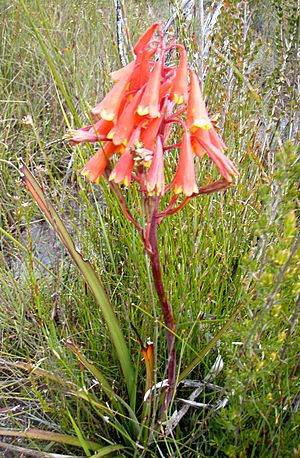Tasmanian Christmas bell facts for kids
Quick facts for kids Tasmanian Christmas bell |
|
|---|---|
 |
|
| Flowers in the Southwest National Park | |
| Scientific classification | |
| Genus: |
Blandfordia
|
| Species: |
punicea
|
| Synonyms | |
|
|
The Tasmanian Christmas bell, also known as Blandfordia punicea, is a beautiful flowering plant. It is special because it grows only in western Tasmania, an island in Australia. This plant is a type of perennial herb, which means it lives for many years and does not have a woody stem. It has long, thin leaves and pretty, bell-shaped flowers. These flowers are usually red on the outside and bright yellow inside.
Contents
What Does the Tasmanian Christmas Bell Look Like?
The Tasmanian Christmas bell is a plant that grows in clumps. It has flat, strap-like leaves that can be 30 to 100 centimeters (about 1 to 3 feet) long. These leaves are 6 to 8 millimeters (about 0.2 to 0.3 inches) wide. They have small teeth along their edges and often have a reddish color.
The plant grows a single, tall stem that does not branch out. This stem can reach up to 1 meter (about 3 feet) tall. On top of this stem, you can find up to twenty bell-shaped flowers. Each flower is 20 to 40 millimeters (about 0.8 to 1.6 inches) long.
The flowers hang down and are attached to the main stem by small stalks called pedicels. These pedicels are 25 to 50 millimeters (about 1 to 2 inches) long. The flowers are mostly red on the outside, with a bright yellow color on the inside. You can often see them standing out above other plants. They usually bloom from mid-spring to early autumn. After the flowers fade, the plant produces a fruit. This fruit is a capsule, which is a dry case holding seeds. It is 25 to 40 millimeters (about 1 to 1.6 inches) long and sits on a stalk about 25 millimeters (about 1 inch) long.
How Was the Tasmanian Christmas Bell Named?
The Tasmanian Christmas bell was first officially described in 1805. A French botanist named Jacques Labillardière gave it the first scientific name, Aletris punicea. He wrote about it in his book Novae Hollandiae Plantarum Specimen.
Later, in 1830, another botanist named Robert Sweet changed its name. He renamed it Blandfordia punicea, which is the name we use today. The second part of its scientific name, punicea, is a Latin word. It means "reddish" or "purplish-red," which perfectly describes the color of its beautiful flowers.
Where Does the Tasmanian Christmas Bell Grow?
The Tasmanian Christmas bell prefers to grow in certain types of environments. You can find it in areas with "button grass," which is a type of plant called Gymnoschoenus sphaerocephalus. It also grows in damp heathlands. These are open areas with low-growing plants, often found in wet, boggy soil.
Most of these plants grow in the western part of Tasmania. You can draw an imaginary line between Bruny Island and Rocky Cape on a map of Tasmania. The Tasmanian Christmas bell mostly grows to the west of this line.
Cultural Significance
The Tasmanian Christmas bell is a well-loved plant in Australia. It was even featured on an Australian 50-cent stamp. This special stamp was released on February 13, 2007, showing how important and recognized this beautiful flower is.

